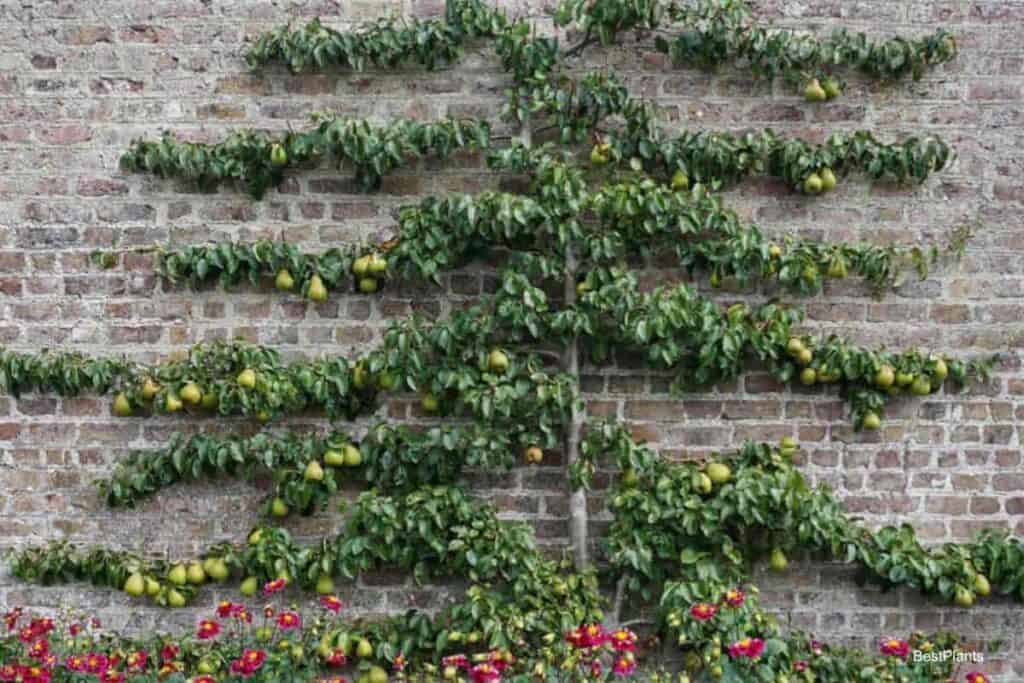For over a century, European gardeners have made the most of their garden space, both decoratively and productively, in training fruit trees by the espalier system.
This method has many points of value to small property owners.

Fruit trees typically grow quite tall and broad and bear a prodigious quantity of fruit.
This is all very well for the orchardist to whom the crop is a business or for the farmer with unlimited space.
But to the homeowner who has a small property, fruit trees in the garden are often more of a nuisance than a boon.
They are too big to spray, prune and pick properly. They also make too much shade for the flowers and vegetables, and at various seasons they litter the ground with dying blossoms, leaves, and over-ripe fruit.
The European Espalier System
The European espalier system of training trees is the answer for those who want a fair amount of high-quality fruit in a limited space.
Since espaliered fruit trees are grown against a building or on a frame, they take up little garden space.
Training may be done along several different patterns, but one of the most satisfactory is where matched branches are trained out horizontally on either side of the main trunk.
These trees may be placed against buildings or walls or on a free-standing framework to serve as a border or screen between houses or various garden sections.
It is wise to provide shade for the trees during part of the day as the fruit does not get much protection against the hot summer sun from its leaves.
Therefore, an eastern or northern exposure is good.
Outstanding Espalier Training Practice
Espalier training can be practiced on standard varieties budded or grafted on dwarfing rootstocks—pears on quince, apples on flounce or Paradise, plums on Prunus mahaleb, and cherries on Mazzard.
When given proper care, espaliered trees will produce a high yield of excellent fruit.
Outstanding use of espalier training has been made by Mr. and Mrs. J. V. G. Posey of Portland, Oregon.
They had two Bartlett pear trees trained over a garden arch at one time, and they liked the results so much they decided to enlarge their “orchard.”
They purchased a group of young trees—pears, apples, and plums—just coming into bearing and already started in the espalier pattern—to line both sides of a grassy garden walk.
The two Bartletts were cut back to below the bottom branches and retained as espaliers to join the new group.
The Poseys installed heavy pipe about 9′ feet high every 12′ feet along each side of the path for support.
Holes were drilled through the pipes, and heavy wire stretched the full length of the rows.
Now, the Poseys have a lane approximately 85′ feet long bordered by 14 trees, seven to a side, the outstretched branches of which touch in uninterrupted lines of green during the summer and fall.
Spring brings a lovely curtain of blossoms 8′ feet high on each side of the walk, and in late summer, the tiers of green leaves are studded with brightly colored fruit.
Pear trees seem to be the most popular for espalier training, and the Posey group bears out that impression.
Of the 14 trees, 8 are pears, ranging from the old reliable Bartlett and Anjou to some less well-known but desirable kinds.
There are the following:
- Small Seckel
- The old-fashioned Good Louise (Louise Bonne de Jersey)
- The impressive Vicar of Wakefield (a huge winter pear)
- A large regal golden variety Duchesse d’Angouleme.
Mingled with the pears are 5 apples—Gravenstein, Golden Russet, and King David—and at the lower end of the line is one Wickson plum.
In another part of the garden, there is the winter pear Easter Beurre.
Caring Practices For Espaliers
Mr. Posey has adopted the espaliers as his special concern, and he takes particular care of them.
Spraying and cultivating are no different from that practiced with trees of standard shape, but pruning is the one attention they demand above all others.
It is a job that cannot be done haphazardly or too hurriedly. Therefore, Mr. Posey gives all the trees a light pruning in spring, usually about April, and concentrates the heavy pruning during August and early September, when growth is the most rapid.
Often starting while the fruit is still on the trees during this late summer season, he has a weekly session with the new lateral shoots.
His trees have reached the maximum height allowed for them by their framework, so it takes a great deal of careful attention to keeping them under control.
Aside from trimming for neatness, the big concern is to leave the fruiting shoots intact and obtain the best possible yield.
Carefully trained espalier trees require a good deal of attention and care, as do most other effective garden displays.
Few efforts will repay the gardener more in satisfaction of a job well done than the cultivation of espalier fruit trees.
At the same time, they literally enable him to enjoy the fruits of his labors.